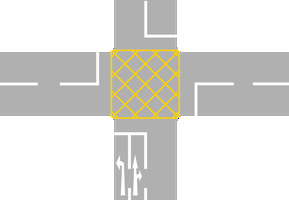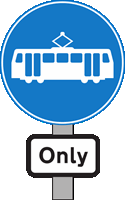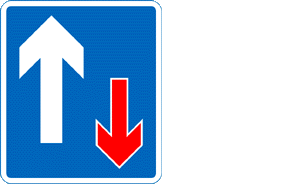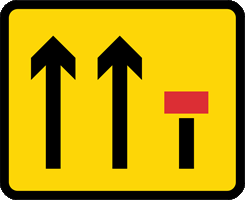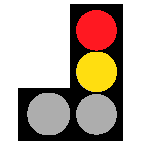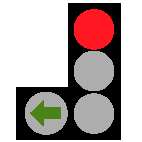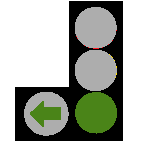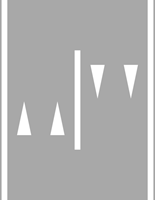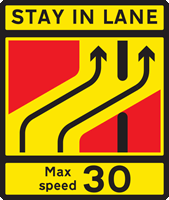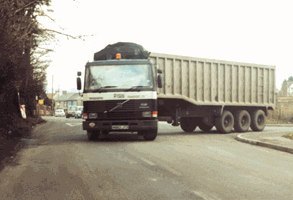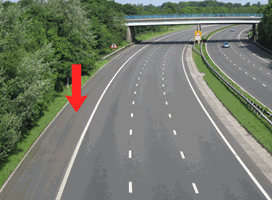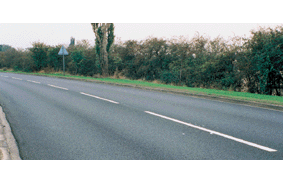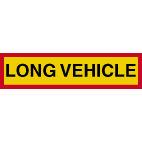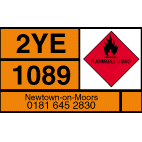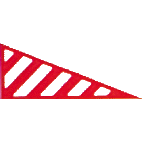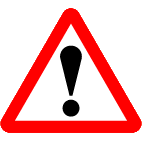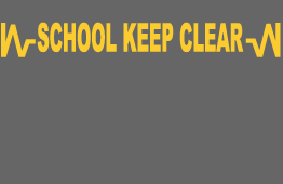
Free Car Theory Test
You have 57 minutes to answer 50 multiple choice theory test questions. You need to answer at least 43 out of 50 questions correctly to pass. You can review your answer after each question or you can review all of your answers at the end of the test. Best of luck!
Click on an answer to view the correct choice along with the explanation.
Correct Answer: A
Explanation: A motorcycle can be lost from sight behind another vehicle. The use of the headlight helps to make it more conspicuous and therefore more easily seen.
Explanation: A motorcycle can be lost from sight behind another vehicle. The use of the headlight helps to make it more conspicuous and therefore more easily seen.
Correct Answer: C
Explanation: The purpose of a box junction is to keep the junction clear by preventing vehicles from stopping in the path of crossing traffic. You must not enter a box junction unless your exit is clear. But, you may enter the box and wait if you want to turn right and are only prevented from doing so by oncoming traffic.
Explanation: The purpose of a box junction is to keep the junction clear by preventing vehicles from stopping in the path of crossing traffic. You must not enter a box junction unless your exit is clear. But, you may enter the box and wait if you want to turn right and are only prevented from doing so by oncoming traffic.
B
C
D
Correct Answer: B
Explanation: A long vehicle may have to straddle lanes either on or approaching a roundabout so that the rear wheels don't cut in over the kerb. If you're following a long vehicle, stay well back and give it plenty of room.
Explanation: A long vehicle may have to straddle lanes either on or approaching a roundabout so that the rear wheels don't cut in over the kerb. If you're following a long vehicle, stay well back and give it plenty of room.
Correct Answer: C
Explanation: There are three basic types of traffic sign, those that warn, inform or give orders. Generally, triangular signs warn, rectangular ones give information or directions, and circular signs usually give orders. An exception is the eight-sided 'STOP' sign.
Explanation: There are three basic types of traffic sign, those that warn, inform or give orders. Generally, triangular signs warn, rectangular ones give information or directions, and circular signs usually give orders. An exception is the eight-sided 'STOP' sign.
Correct Answer: D
Explanation: Avoid blocking tram routes. Trams are fixed on their route and can't manoeuvre around other vehicles and pedestrians. Modern trams travel quickly and are quiet so you might not hear them approaching.
Explanation: Avoid blocking tram routes. Trams are fixed on their route and can't manoeuvre around other vehicles and pedestrians. Modern trams travel quickly and are quiet so you might not hear them approaching.
Correct Answer: D
Explanation: Don't force your way through if oncoming vehicles fail to give way. If necessary, slow down and give way to avoid confrontation or a collision.
Explanation: Don't force your way through if oncoming vehicles fail to give way. If necessary, slow down and give way to avoid confrontation or a collision.
Correct Answer: D
Explanation: Yellow and black temporary signs may be used to inform you of roadworks or lane restrictions. Look well ahead. If you have to change lanes, do so in good time.
Explanation: Yellow and black temporary signs may be used to inform you of roadworks or lane restrictions. Look well ahead. If you have to change lanes, do so in good time.
8. You are in the left-hand lane at traffic lights. You are waiting to turn left. At which of these traffic lights must you NOT move on?
Mark one answer
B
C
D
Correct Answer: A
Explanation: At some junctions there may be a separate signal for different lanes. These are called 'filter' lights. They're designed to help traffic flow at major junctions. Make sure that you're in the correct lane and proceed if the way is clear and the green light shows for your lane.
Explanation: At some junctions there may be a separate signal for different lanes. These are called 'filter' lights. They're designed to help traffic flow at major junctions. Make sure that you're in the correct lane and proceed if the way is clear and the green light shows for your lane.
Correct Answer: D
Explanation: Due to the dark colour of the road, changes in level aren't easily seen. White triangles painted on the road surface give you an indication of where there are road humps.
Explanation: Due to the dark colour of the road, changes in level aren't easily seen. White triangles painted on the road surface give you an indication of where there are road humps.
10. At this junction there is a stop sign with a solid white line on the road surface. Why is there a stop sign here?
Mark one answer
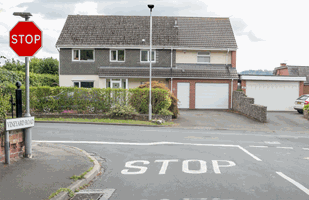
B
C
D
Correct Answer: D
Explanation: If your view is restricted at a road junction you must stop. There may also be a 'stop' sign. Don't emerge until you're sure there's no traffic approaching. IF YOU DON'T KNOW, DON'T GO.
Explanation: If your view is restricted at a road junction you must stop. There may also be a 'stop' sign. Don't emerge until you're sure there's no traffic approaching. IF YOU DON'T KNOW, DON'T GO.
11. You have broken down on a motorway. To find the nearest emergency telephone you should always walk
Mark one answer
B
C
D
Correct Answer: C
Explanation: Along the hard shoulder there are marker posts at 100-metre intervals. These will direct you to the nearest emergency telephone.
Explanation: Along the hard shoulder there are marker posts at 100-metre intervals. These will direct you to the nearest emergency telephone.
Correct Answer: A
Explanation: Learners might not have confidence when they first start to drive. Allow them plenty of room and don't react adversely to their hesitation. We all learn from experience, but new drivers will have had less practice in dealing with all the situations that might occur.
Explanation: Learners might not have confidence when they first start to drive. Allow them plenty of room and don't react adversely to their hesitation. We all learn from experience, but new drivers will have had less practice in dealing with all the situations that might occur.
13. You are on a motorway in fog. The left-hand edge of the motorway can be identified by reflective studs. What colour are they?
Mark one answer

B
C
D
Correct Answer: C
Explanation: Be especially careful if you're on a motorway in fog. Reflective studs are used to help you in poor visibility. Different colours are used so that you'll know which lane you are in. These are
- red on the left-hand side of the road,
- white between lanes,
- amber on the right-hand edge of the carriageway,
- green between the carriageway and slip roads.
Explanation: Be especially careful if you're on a motorway in fog. Reflective studs are used to help you in poor visibility. Different colours are used so that you'll know which lane you are in. These are
- red on the left-hand side of the road,
- white between lanes,
- amber on the right-hand edge of the carriageway,
- green between the carriageway and slip roads.
14. You are joining a motorway. Why is it important to make full use of the slip road?
Mark one answer
B
C
D
Correct Answer: D
Explanation: Try to join the motorway without affecting the progress of the traffic already travelling on it. Always give way to traffic already on the motorway. At busy times you may have to slow down to merge into slow-moving traffic.
Explanation: Try to join the motorway without affecting the progress of the traffic already travelling on it. Always give way to traffic already on the motorway. At busy times you may have to slow down to merge into slow-moving traffic.
Correct Answer: B
Explanation: There's likely to be a speed restriction in force. Keep to this. Don't
- switch lanes,
- get too close to traffic in front of you. Be aware there will be no permanent barrier between you and the oncoming traffic.
Explanation: There's likely to be a speed restriction in force. Keep to this. Don't
- switch lanes,
- get too close to traffic in front of you. Be aware there will be no permanent barrier between you and the oncoming traffic.
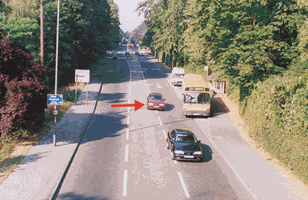
B
C
D
Correct Answer: D
Explanation: If you can do so safely give way to buses signalling to move off at bus stops. Try to anticipate the actions of other road users around you. The driver of the red car should be prepared for the bus pulling out. As you approach a bus stop look to see how many passengers are waiting to board. If the last one has just got on, the bus is likely to move off.
Explanation: If you can do so safely give way to buses signalling to move off at bus stops. Try to anticipate the actions of other road users around you. The driver of the red car should be prepared for the bus pulling out. As you approach a bus stop look to see how many passengers are waiting to board. If the last one has just got on, the bus is likely to move off.
Correct Answer: D
Explanation: When turning, long vehicles need much more room on the road than other vehicles. At junctions they may take up the whole of the road space, so be patient and allow them the room they need.
Explanation: When turning, long vehicles need much more room on the road than other vehicles. At junctions they may take up the whole of the road space, so be patient and allow them the room they need.
Correct Answer: C
Explanation: Don't use the hard shoulder for stopping unless it is an emergency. If you want to stop for any other reason go to the next exit or service station.
Explanation: Don't use the hard shoulder for stopping unless it is an emergency. If you want to stop for any other reason go to the next exit or service station.
19. You are travelling on a well-lit road at night in a built-up area. By using dipped headlights you will be able to
Mark one answer
B
C
D
Correct Answer: A
Explanation: You may be difficult to see when you're travelling at night, even on a well lit road. If you use dipped headlights rather than sidelights other road users will see you more easily.
Explanation: You may be difficult to see when you're travelling at night, even on a well lit road. If you use dipped headlights rather than sidelights other road users will see you more easily.
20. You see this amber traffic light ahead. Which light or lights, will come on next?
Mark one answer
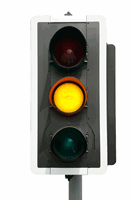
B
C
D
Correct Answer: C
Explanation: At junctions controlled by traffic lights you must stop behind the white line until the lights change to green. Red and amber lights showing together also mean stop.You may proceed when the light is green unless your exit road is blocked or pedestrians are crossing in front of you.If you're approaching traffic lights that are visible from a distance and the light has been green for some time they are likely to change. Be ready to slow down and stop.
Explanation: At junctions controlled by traffic lights you must stop behind the white line until the lights change to green. Red and amber lights showing together also mean stop.You may proceed when the light is green unless your exit road is blocked or pedestrians are crossing in front of you.If you're approaching traffic lights that are visible from a distance and the light has been green for some time they are likely to change. Be ready to slow down and stop.
Correct Answer: C
Explanation: A long white line with short gaps means that you are approaching a hazard. If you do need to cross it, make sure that the road is clear well ahead.
Explanation: A long white line with short gaps means that you are approaching a hazard. If you do need to cross it, make sure that the road is clear well ahead.
Correct Answer: D
Explanation: Pull onto the hard shoulder and use the emergency telephone to report your problem. This lets the emergency services know your exact location so they can send help. Never cross the carriageway to use the telephone on the other side.
Explanation: Pull onto the hard shoulder and use the emergency telephone to report your problem. This lets the emergency services know your exact location so they can send help. Never cross the carriageway to use the telephone on the other side.
23. You are in an Active Traffic Management area on a motorway. When the Actively Managed mode is operating
Mark one answer
B
C
D
Correct Answer: A
Explanation: When an Active Traffic Management (ATM) scheme is operating on a motorway you MUST follow the mandatory instructions shown on the gantries above each lane. This includes the hard shoulder.
Explanation: When an Active Traffic Management (ATM) scheme is operating on a motorway you MUST follow the mandatory instructions shown on the gantries above each lane. This includes the hard shoulder.
24. You are travelling on a motorway in England. You MUST stop when signalled to do so by which of these?
Mark one answer
B
C
D
Correct Answer: B
Explanation: You'll find traffic officers on England's motorways. They work in partnership with the police, helping to keep traffic moving and to make your journey as safe as possible. It is an offence not to comply with the directions given by a traffic officer.
Explanation: You'll find traffic officers on England's motorways. They work in partnership with the police, helping to keep traffic moving and to make your journey as safe as possible. It is an offence not to comply with the directions given by a traffic officer.
Correct Answer: B
Explanation: Transport is an essential part of modern life but it does have environmental effects. In heavily populated areas traffic is the biggest source of air pollution. Ecosafe driving and riding will reduce emissions and can make a surprising difference to local air quality.
Explanation: Transport is an essential part of modern life but it does have environmental effects. In heavily populated areas traffic is the biggest source of air pollution. Ecosafe driving and riding will reduce emissions and can make a surprising difference to local air quality.
26. In front of you is a class 3 powered vehicle (powered wheelchair) driven by a disabled person. These vehicles have a maximum speed of
Mark one answer
B
C
D
Correct Answer: D
Explanation: These vehicles are battery powered and very vulnerable due to their slow speed, small size and low height. Some are designed for pavement and road use and have a maximum speed of 8 mph (12 km/h). Others are for pavement use only and are restricted to 4 mph (6 km/h). Take extra care and be patient if you are following one. Allow plenty of room when overtaking and do not go past unless you can do so safely.
Explanation: These vehicles are battery powered and very vulnerable due to their slow speed, small size and low height. Some are designed for pavement and road use and have a maximum speed of 8 mph (12 km/h). Others are for pavement use only and are restricted to 4 mph (6 km/h). Take extra care and be patient if you are following one. Allow plenty of room when overtaking and do not go past unless you can do so safely.
27. You arrive at an incident. It has just happened and someone is injured. Which THREE should be given urgent priority?
Mark three answers
B
C
D
E
F
Correct Answer: A, B, E
Explanation: The first priority with a casualty is to make sure their airway is clear and they are breathing. Any wounds should be checked for objects and then bleeding stemmed using clean material. Ensure the emergency services are called, they are the experts. If you're not first aid trained consider getting training. It might save a life.
Explanation: The first priority with a casualty is to make sure their airway is clear and they are breathing. Any wounds should be checked for objects and then bleeding stemmed using clean material. Ensure the emergency services are called, they are the experts. If you're not first aid trained consider getting training. It might save a life.
28. A tanker is involved in a collision. Which sign shows that it is carrying dangerous goods?
Mark one answer
B
C
D
Correct Answer: B
Explanation: There will be an orange label on the side and rear of the tanker. Look at this carefully and report what it says when you phone the emergency services. Details of hazard warning plates are given in The Highway Code.
Explanation: There will be an orange label on the side and rear of the tanker. Look at this carefully and report what it says when you phone the emergency services. Details of hazard warning plates are given in The Highway Code.
Correct Answer: A, D
Explanation: Uneven wear on your tyres can be caused by the condition of your vehicle. Having it serviced regularly will ensure that the brakes, steering and wheel alignment are maintained in good order.
Explanation: Uneven wear on your tyres can be caused by the condition of your vehicle. Having it serviced regularly will ensure that the brakes, steering and wheel alignment are maintained in good order.
Correct Answer: B
Explanation: If you're involved in a collision, head restraints will reduce the risk of neck injury. They must be properly adjusted. Make sure they aren't positioned too low, in a crash this could cause damage to the neck.
Explanation: If you're involved in a collision, head restraints will reduce the risk of neck injury. They must be properly adjusted. Make sure they aren't positioned too low, in a crash this could cause damage to the neck.
Correct Answer: B
Explanation: As you look through the rear of your vehicle you may not be able to see a small child. Be aware of this before you reverse. If there are children about, get out and check if it is clear before reversing.
Explanation: As you look through the rear of your vehicle you may not be able to see a small child. Be aware of this before you reverse. If there are children about, get out and check if it is clear before reversing.
Correct Answer: A
Explanation: When you're on country roads be aware of particular dangers. Be prepared for farm animals, horses, pedestrians, farm vehicles and wild animals. Always be prepared to slow down or stop.
Explanation: When you're on country roads be aware of particular dangers. Be prepared for farm animals, horses, pedestrians, farm vehicles and wild animals. Always be prepared to slow down or stop.
33. You are driving in town. Ahead of you a bus is at a bus stop. Which TWO of the following should you do?
Mark two answers
B
C
D
Correct Answer: A, D
Explanation: As you approach, look out for any signal the driver might make. If you pass the vehicle watch out for pedestrians attempting to cross the road from the other side of the bus. They will be hidden from view until the last moment.
Explanation: As you approach, look out for any signal the driver might make. If you pass the vehicle watch out for pedestrians attempting to cross the road from the other side of the bus. They will be hidden from view until the last moment.
34. You are driving on a motorway. By mistake, you go past the exit that you wanted to take. You should
Mark one answer
B
C
D
Correct Answer: C
Explanation: It is against the law to reverse, cross the central reservation or drive against the traffic flow on a motorway. If you have missed your exit ask yourself if your concentration is fading. It could be that you need to take a rest break before completing your journey.
Explanation: It is against the law to reverse, cross the central reservation or drive against the traffic flow on a motorway. If you have missed your exit ask yourself if your concentration is fading. It could be that you need to take a rest break before completing your journey.
Correct Answer: D, E
Explanation: Poor contact with the road surface could cause one or more of the tyres to lose grip on the road. This is more likely to happen when braking in poor weather conditions, when the road surface is uneven or has loose chippings.
Explanation: Poor contact with the road surface could cause one or more of the tyres to lose grip on the road. This is more likely to happen when braking in poor weather conditions, when the road surface is uneven or has loose chippings.
36. Your vehicle has anti-lock brakes, but they may not always prevent skidding. This is most likely to happen when driving
Mark two answers
B
C
D
E
Correct Answer: D, E
Explanation: In very wet weather water can build up between the tyre and the road surface. As a result your vehicle actually rides on a thin film of water and your tyres will not grip the road. Gravel or shingle surfaces also offer less grip and can present problems when braking. An anti-lock braking system may be ineffective in these conditions.
Explanation: In very wet weather water can build up between the tyre and the road surface. As a result your vehicle actually rides on a thin film of water and your tyres will not grip the road. Gravel or shingle surfaces also offer less grip and can present problems when braking. An anti-lock braking system may be ineffective in these conditions.
Correct Answer: A
Explanation: Fog lights can be brighter than normal dipped headlights. If the weather has improved turn them off to avoid dazzling other road users.
Explanation: Fog lights can be brighter than normal dipped headlights. If the weather has improved turn them off to avoid dazzling other road users.
Correct Answer: A
Explanation: If you have to leave valuables in your car, always lock them out of sight. If you can see them, so can a thief.
Explanation: If you have to leave valuables in your car, always lock them out of sight. If you can see them, so can a thief.
Correct Answer: C, D
Explanation: Make sure that the vehicle you're driving is well ventilated. A warm, stuffy atmosphere will make you feel drowsy. Open a window and turn down the heating.
Explanation: Make sure that the vehicle you're driving is well ventilated. A warm, stuffy atmosphere will make you feel drowsy. Open a window and turn down the heating.
Correct Answer: B, C
Explanation: The fuel in your vehicle can be a dangerous fire hazard. Never
- use a naked flame near the vehicle if you can smell fuel,
- smoke when refuelling your vehicle.
Explanation: The fuel in your vehicle can be a dangerous fire hazard. Never
- use a naked flame near the vehicle if you can smell fuel,
- smoke when refuelling your vehicle.
41. You are away from home and have to park your vehicle overnight. Where should you leave it?
Mark one answer
B
C
D
Correct Answer: B
Explanation: When leaving your vehicle unattended, use a secure car park whenever possible.
Explanation: When leaving your vehicle unattended, use a secure car park whenever possible.
Correct Answer: C
Explanation: Releasing the brake before you have slowed right down will disable the system. If you have to brake in an emergency ensure that you keep your foot firmly on the brake pedal until the vehicle has stopped.
Explanation: Releasing the brake before you have slowed right down will disable the system. If you have to brake in an emergency ensure that you keep your foot firmly on the brake pedal until the vehicle has stopped.
Correct Answer: A
Explanation: When surface spray reduces visibility switch on your dipped headlights. This will help other road users to see you.
Explanation: When surface spray reduces visibility switch on your dipped headlights. This will help other road users to see you.
44. You have to make a journey in fog. What are the TWO most important things you should do before you set out?
Mark two answers
B
C
D
E
Correct Answer: A, C
Explanation: Don't drive in fog unless you really have to. Adjust your driving to the conditions. You should always be able to pull up within the distance you can see ahead.
Explanation: Don't drive in fog unless you really have to. Adjust your driving to the conditions. You should always be able to pull up within the distance you can see ahead.
45. Your vehicle breaks down on the hard shoulder of a motorway. You decide to use your mobile phone to call for help. You should
Mark one answer
B
C
D
Correct Answer: A
Explanation: The emergency services need to know your exact location so they can reach you as quickly as possible. Look for a number on the nearest marker post beside the hard shoulder. Give this number when you call the emergency services as it will help them to locate you. Be ready to describe where you are, for example, by reference to the last junction or service station you passed.
Explanation: The emergency services need to know your exact location so they can reach you as quickly as possible. Look for a number on the nearest marker post beside the hard shoulder. Give this number when you call the emergency services as it will help them to locate you. Be ready to describe where you are, for example, by reference to the last junction or service station you passed.
46. You wish to tow a trailer. Where would you find the maximum noseweight of your vehicle's tow ball?
Mark one answer
B
C
D
Correct Answer: B
Explanation: You must know how to load your trailer or caravan so that the hitch exerts a downward force onto the tow ball. This information can be found in your vehicle handbook or from your vehicle manufacturer's agent.
Explanation: You must know how to load your trailer or caravan so that the hitch exerts a downward force onto the tow ball. This information can be found in your vehicle handbook or from your vehicle manufacturer's agent.
Correct Answer: D
Explanation: Sometimes you may not be able to see that the road is icy. Black ice makes a road look damp. The signs that you're travelling on black ice can be that
- the steering feels light,
- the noise from your tyres suddenly goes quiet.
Explanation: Sometimes you may not be able to see that the road is icy. Black ice makes a road look damp. The signs that you're travelling on black ice can be that
- the steering feels light,
- the noise from your tyres suddenly goes quiet.
48. You are parked at the side of the road. You will be waiting for some time for a passenger. What should you do?
Mark one answer
B
C
D
Correct Answer: B
Explanation: If your vehicle is stationary and is likely to remain so for some time, switch off the engine. We should all try to reduce global warming and pollution.
Explanation: If your vehicle is stationary and is likely to remain so for some time, switch off the engine. We should all try to reduce global warming and pollution.
Correct Answer: D
Explanation: Where there are yellow zigzag markings, you should not park, wait or stop, even to pick up or drop off children. A vehicle parked on the zigzag lines would obstruct children's view of the road and other drivers view of the pavement. Where there is an upright sign there is mandatory prohibition of stopping during the times shown.
Explanation: Where there are yellow zigzag markings, you should not park, wait or stop, even to pick up or drop off children. A vehicle parked on the zigzag lines would obstruct children's view of the road and other drivers view of the pavement. Where there is an upright sign there is mandatory prohibition of stopping during the times shown.
50. Your vehicle has broken down on an automatic railway level crossing. What should you do FIRST?
Mark one answer
B
C
D
Correct Answer: A
Explanation: Firstly get yourself and anyone else well away from the crossing. If there's a railway phone use that to get instructions from the signal operator. Then if there's time move the vehicle clear of the crossing.
Explanation: Firstly get yourself and anyone else well away from the crossing. If there's a railway phone use that to get instructions from the signal operator. Then if there's time move the vehicle clear of the crossing.
These mock tests cover the 2012-2018 official DVSA revision bank which consisted of 963 questions. Please click here if you’d like to access the latest mock tests.



